Melanotan Peptides
Buy Melanotan Peptides Online From Direct Sarms Sweden
Melanotan research peptides are designed to mimic the natural hormone α-melanocyte-stimulating hormone (α-MSH), which helps stimulate melanocytes to produce eumelanin, leading to skin darkening and protection against UV radiation.
Melanotan peptides can help Sweden scientists, researchers, and medical professionals explore skin pigmentation, sunless tanning, photoprotection, and medicinal applications of melanogenesis.
-
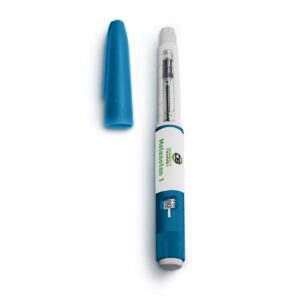 TOP SELLER
TOP SELLERSave 10%
Melanotan 1 Pre Mixed Peptide 10mg
$25.99 – $70.16 This product has multiple variants. The options may be chosen on the product page -
 TOP SELLER
TOP SELLERMelanotan 1 Nasal Spray
$32.76 – $59.28 This product has multiple variants. The options may be chosen on the product page -
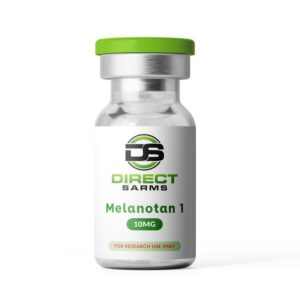 VALUE PACK
VALUE PACKMelanotan 1 Peptide Vial 10mg
$22.76 – $77.38 This product has multiple variants. The options may be chosen on the product page -
 TOP SELLER
TOP SELLERMelanotan 2 Pre Mixed Peptide 10mg
$27.25 – $73.58 This product has multiple variants. The options may be chosen on the product page -
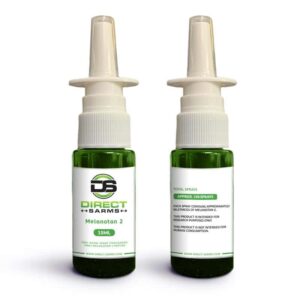 TWIN PACK
TWIN PACKMelanotan 2 Nasal Spray
$34.03 – $111.24 This product has multiple variants. The options may be chosen on the product page -
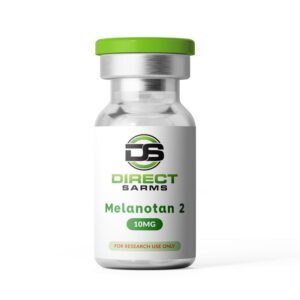 TWIN PACK
TWIN PACKMelanotan 2 Peptide Vial 10mg
$24.03 – $43.25 This product has multiple variants. The options may be chosen on the product page
What are the suggested research benefits of Melanotan Peptides?
- Skin Cancer Prevention: Sweden Research has focused on Melanotan peptides, synthetic versions of a naturally occurring hormone, for their potential to lower skin cancer risk. They stimulate melanin production, the pigment that colors skin, providing a stronger natural barrier against harmful UV radiation, a leading cause of skin cancer. By boosting skin’s protection, Melanotan peptides show promise in preventing skin cancer development.
- Safer Tanning with Less UV: Sweden Studies show that Melanotan peptides can induce tanning without the need for extended UV exposure. This method greatly reduces the risk of skin damage and health issues linked to UV radiation. Mimicking natural tanning safely, Melanotan peptides provide a safer option for achieving a sun-kissed look without the harmful effects of conventional tanning methods.
- Potential Treatment for Erectile Dysfunction: Research and Sweden clinical investigations have explored the efficacy of MT-2 in enhancing sexual function, indicating its promise as a potential treatment for erectile dysfunction. By mimicking certain natural functions in the body related to sexual arousal, Melanotan 2 offers hope for individuals seeking alternatives to traditional erectile dysfunction treatments.
- Appetite Suppression and Weight Management: Recent studies indicate that Melanotan 2 might help regulate appetite by signaling the brain to reduce hunger. This peptide could be a useful tool for those aiming to manage their weight or seeking obesity treatment options. By potentially reducing food cravings, Melanotan 2 shows promise in supporting weight management efforts and addressing obesity-related health problems.
- Regulation of Energy Homeostasis: Melanotan peptides, synthetic compounds similar to hormones involved in melanogenesis, are linked to regulating the body’s energy balance. This connection reveals their potential in influencing metabolic processes, indicating possible therapeutic uses for metabolic disorders. By interacting with melanocortin receptors, these peptides may play a crucial role in the body’s energy regulation, opening new research and treatment paths for obesity and related metabolic conditions.
- Impulse Control and Addiction: Research into Melanotan peptides has explored their effects on impulse control and addiction. MT-II, which acts on the melanocortin receptors MC4R and MC3R involved in reward pathways and behavior, shows promise in modifying impulse control and addiction behaviors. These findings suggest MT-II could help manage compulsive disorders, substance abuse, and other addictive behaviors. However, more in-depth Sweden studies are needed to fully grasp Melanotan peptides’ roles in these areas. It’s crucial that any potential treatments are closely monitored and evaluated in clinical settings.
What is the difference between Melanotan 1 and Melanotan 2?
Both peptides are synthetic analogs of the alpha-melanocyte-stimulating hormone (α-MSH), and are used primarily for their skin pigmentation effects. However, they differ in their molecular structure, effects, and potential applications.
What is Melanotan 1?
Melanotan 1 (also known as Afamelanotide; Melanotan I; MT-1; or MT-I) is a synthetic analog of the alpha-melanocyte-stimulating hormone (α-MSH), which plays a key role in the pigmentation of skin. Initially developed to aid in the prevention of skin cancer by inducing tanning without exposure to harmful UV rays, MT-1 mimics the body’s natural tanning process. It binds to melanocortin receptors, stimulating the production of melanin in the skin, which results in a deeper skin tone. Due to its potential to promote skin pigmentation, it has garnered interest not only in medical fields but also for cosmetic purposes. However, it is critical to note that the use of Melanotan 1 should be under strict medical supervision, and it is subject to regulatory approvals in various markets.
Buy Melanotan 1 Peptide Vial today from Sweden Direct Sarms! (Available as a single 10mg vial and also a kit which includes bateriostatic water and syringes)
How Does Melanotan 1 Work?
Melanotan 1 functions by mimicking the effects of the natural hormone alpha-melanocyte-stimulating hormone (α-MSH). When administered, it binds to melanocortin receptors, specifically the MC1R receptor found in melanocytes, which are the cells responsible for producing melanin in the skin. This binding action stimulates these melanocytes to produce more melanin, the pigment responsible for skin, hair, and eye color. As melanin levels increase, skin pigmentation darkens, providing a protective barrier against UV radiation. This process results in a tanning effect without the need for prolonged sun exposure, thereby reducing the risk of skin damage
and potential skin cancer development. The effectiveness and duration of the tanning effect can vary based on individual skin types and the dosage administered.
Melanotan 1 Specifications
Molecular Formula: C78H111N21O19
Molecular Weight: 1646.8 g/mol
Sequence: Ac-Ser-Tyr-Ser-Nle-Glu-His-D-Phe-Arg-Trp-Gly-Lys-Pro-Val-NH2
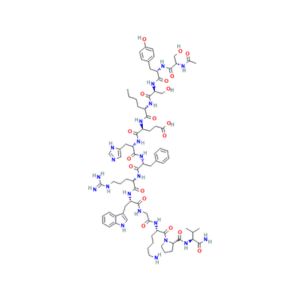 Source: PubChem
Source: PubChem
Access our Melanotan 1 High-Performance Liquid Chromatography (HPLC) Certificate here.
What is Melanotan 2?
Melanotan 2, also known as Melanotan II; MT-2; or MT-II, was developed in the 1990’s by the University of Arizona. It is another synthetic analog of the alpha-melanocyte-stimulating hormone (α-MSH). Similar to Melanotan 1, it promotes increased melanin production in the skin, thereby enhancing pigmentation and mimicking the natural tanning process. In addition to its tanning effects, MT-2 has been studied for its potential to influence sexual function, appetite regulation, and energy homeostasis, making it a compound of interest in various research fields. Despite its potential benefits, MT-2 also carries risks and side effects that necessitate cautious use under medical guidance. Regulatory approval and legal status of Melanotan 2 vary across different countries, hence it is essential for users to be aware of the legal implications in their respective regions.
Buy Melanotan 2 10mg Peptide Vial from Sweden Direct Sarms today! (Buy 10mg vial or a kit that contains bacteriostatic water and syringes for reconstituting.)
How Does Melanotan 2 Work?
Melanotan 2 operates by mimicking the natural alpha-melanocyte-stimulating hormone (α-MSH) in the body. When introduced, it binds to melanocortin receptors, primarily MC1R found in melanocytes, which are responsible for melanin production. This interaction stimulates increased melanin synthesis, resulting in enhanced skin pigmentation. Beyond its effects on tanning, MT-2 also influences other melanocortin receptors, including MC4R, which have roles in regulating sexual function, appetite, and energy balance. Consequently, users may experience additional physiological effects such as libido changes or appetite suppression.
Given its broad range of actions and potential side effects, the administration of MT-II should be carefully managed and monitored by healthcare professionals. It is important to adhere to regulatory guidelines and consider the legal status of MT-II in the respective region before use.
Melanotan 2 Specifications
Molecular Formula: C50H69N15O9
Molecular Weight: 1024.2 g/mol
Sequence: Ac-Nle-Asp(1)-His-D-Phe-Arg-Trp-Lys(1)-NH2
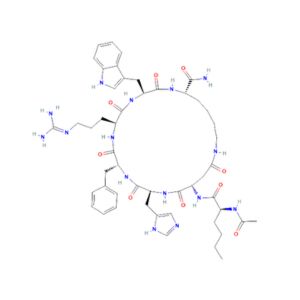 Source: PubChem
Source: PubChem
View the Melanotan 2 High-Performance Liquid Chromatography (HPLC) Certificate here.
What are the Pros and Cons between MT-1 and MT-2?
Melanotan 1 Peptides
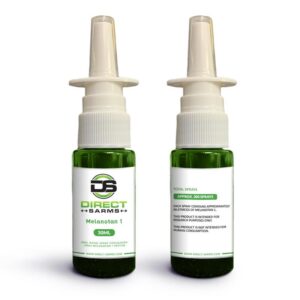
Buy Melanotan 1 nasal spray (MT-1) for clinical research from Sweden Direct Sarms, available in 15ml and 30ml bottles.
Pros:
- Safety Profile: MT-1 has a more favorable safety profile compared to MT-2, with fewer reported side effects.
- Targeted Action: It specifically targets MC1R receptors on melanocytes, leading to sustained and proportional pigmentation with reduced risk of over-stimulation.
- Regulatory Approval: In some markets, MT-1 has achieved regulatory approval for certain medical uses, enhancing its credibility and accessibility for treatment purposes.
Cons:
- Limited Additional Therapeutic Effects: Unlike MT-2, MT-1 does not impact other melanocortin receptors significantly, limiting its potential benefits beyond pigmentation.
- Higher Dosage Requirement: May require a higher dosage to achieve desired tanning effects, which could translate to increased costs and duration of treatment.
Melanotan 2 Peptides
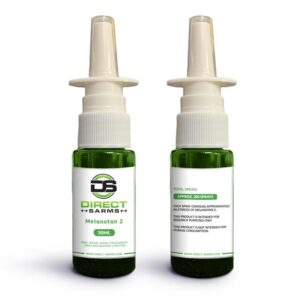
Buy Melanotan II nasal sprays (MT-2) Peptides for research from Direct Sarms Sweden.
Pros:
- Multi-Receptor Influence: Melanotan 2 binds to multiple melanocortin receptors (MC1R and MC4R), offering additional benefits such as enhanced libido, potential appetite suppression, and energy balance regulation.
- Potency: More potent than MT-1, often requiring smaller doses to achieve similar or more pronounced effects.
- Appetite Suppression and Weight Management: Research indicates potential benefits for weight management and appetite control, expanding its therapeutic use cases.
Cons:
- Side Effects: Due to its broader receptor activity, MT-2 is associated with more side effects such as nausea, flushing, and unintentional libido changes.
- Regulatory Status: Its legal status varies significantly across countries, which can complicate accessibility and adherence to regulatory compliance.
- Complexity in Usage: Due to the wide range of physiological effects, the administration of MT-2 requires thorough medical supervision and monitoring.
Frequently Asked Questions (FAQ’s) about Melanotan Peptides
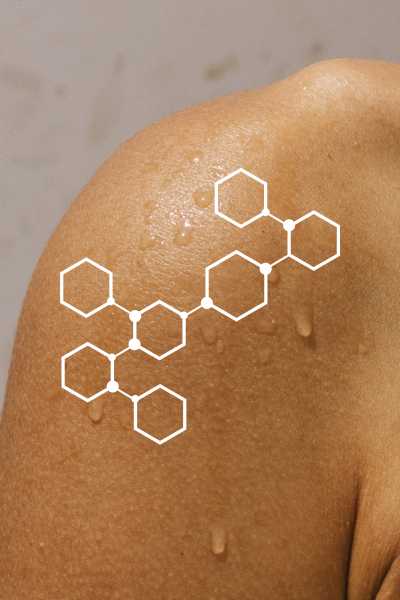
Are Melanotan peptides legal?
The legal status of these peptides varies by country so you will need to check your local laws and regulations. However, it is important to remember that Melanotan products are research compounds and are not intended for human consumption:
United States: Melanotan peptides have not been approved by the Food and Drug Administration (FDA) for medical or cosmetic use, making their sale and distribution illegal for personal use.
United Kingdom: These peptides are not licensed by the Medicines and Healthcare products Regulatory Agency (MHRA), and their marketing and sale are prohibited. It is crucial to note that these peptides are designated for research purposes only.
Australia: The Therapeutic Goods Administration (TGA) has also not approved Melanotan peptides for medical or cosmetic applications, classifying them as unregulated products that should not be sold or advertised.
Are Melanotan peptides safe to use?
Research suggests potential benefits of Melanotan peptides, but their safety is still being evaluated. They can cause side effects like nausea, flushing, and changes in libido, requiring caution. Sweden Researchers should conduct in-depth studies to fully understand the risks and mechanisms involved. Any use should be under medical supervision, and it’s crucial to follow local regulations for safety and compliance.
How are Melanotan peptides administered?
Melanotan peptides are usually given through subcutaneous injections or nasal sprays, with the dosage and frequency varying by peptide and desired tan effect. Melanotan nasal sprays can be a more comfortable alternative to injections, possibly increasing user compliance. However, their effectiveness and absorption rates may not match those of injections, and more research is needed for optimization. Medical professionals should manage administration in clinical settings to ensure correct dosing and watch for side effects.
Can Melanotan peptides be used for weight management?
Research suggests that MT-2 may influence appetite suppression and energy balance, offering potential benefits for weight management and obesity treatment. However, these effects require further validation through comprehensive clinical studies.
What potential side effects should researchers be aware of?
Common side effects of Melanotan peptides include nausea, vomiting, flushing, increased libido, and appetite changes. More severe side effects can occur, especially with MT-2, due to its broader receptor activity. Due to these potential side effects, researchers should consult healthcare professionals before conducting any clinical trials or studying these compounds.
Further Reading
For more information, explore our latest blog posts dedicated to Melanotan peptides.
Buy Melanotan Peptides Today!
Direct Sarms Sweden offers an extensive range of high-quality Melanotan peptides for sale, available in multiple formats to accommodate the diverse needs of researchers. Our selection includes peptide vials (available in 10mg vials and also kits with bacteriostatic water and syringes), nasal sprays 15ml and 30ml, and pre-mixed pens, offering versatile options for purchase.
Scientific References
[1] R.T.Dorr, G.Ertl and N.Levine (2004) Effects of a Superpotent Melanotropic Peptide in Combination With Solar UV Radiation on Tanning of the Skin in Human Volunteers – Jama Dermatology, 2004;140(7):827-835.
[2] L.M.Fitzgerald, J.L.Fryer, T.Dwyer, and S.M.Humphrey (2006) Effect of MELANOTAN, [Nle(4), D-Phe(7)]-alpha-MSH, on melanin synthesis in humans with MC1R variant alleles – Peptides, Volume 27, Issue 2, February 2006, Pages 388-394.
[3] H.Wessells, K.Fuciarelli, J.Hansen et al (1998) Synthetic melanotropic peptide initiates erections in men with psychogenic erectile dysfunction: double-blind, placebo controlled crossover study – Journal of Urology, 1998 Aug;160(2):389-93.
[4] H.Wessells, V.J.Hruby, J.Hackett et al (2006) MT-II Induces Penile Erection via Brain and Spinal Mechanisms – Annals of the New York Academy of Sciences, Volume 994, Issue 1, The Melanocortin System, June 2003, Pages 90-95.
[5] J.Ji An, Y.Rhee, S.H.Kim et al (2007) Peripheral effect of alpha-melanocyte-stimulating hormone on fatty acid oxidation in skeletal muscle – The Journal of Biological Chemistry, 2007 Feb 2;282(5):2862-70.
[6] Wessells, K.Fuciarelli, and J.Hansen (1998) Synthetic melanotropic peptide initiates erections in men with psychogenic erectile dysfunction: Double-blind placebo controlled crossover study – International Journal of Impotence Research volume 10, page263 (1998).
[7] C.Laustrup Møller, K.Raun et al (2011) Characterization of murine melanocortin receptors mediating adipocyte lipolysis and examination of signalling pathways involved – Molecular and Cellular Endocrinology, 2011 Jul 20;341(1-2):9-17.
[8] M.Navarro, F.Carvajal, J.M.Lerma-Cabrera et al (2015) Evidence that Melanocortin Receptor Agonist Melanotan-II Synergistically Augments the Ability of Naltrexone to Blunt Binge-Like Ethanol Intake in Male C57BL/6J Mice – Alcoholism, Clinical and Experimental Research, 2015 Aug;39(8):1425-33.
[9] D.A.York, S.Boghossian, M.Park-York (2011) Melanocortin activity in the amygdala influences alcohol intake – Pharmacology, Biochemistry and Behaviour, 2011 Mar;98(1):112-9.
ALL CONTENT AND PRODUCT INFORMATION AVAILABLE ON THIS WEBSITE IS FOR EDUCATIONAL PURPOSES ONLY.
DISCLAIMER: These products are intended solely as a research chemical only. This classification allows for their use only for research development and laboratory studies. The information available on our Sweden Direct Sarms website is provided for educational purposes only. These products are not for human or animal use or consumption in any manner. Handling of these products should be limited to suitably qualified professionals. They are not to be classified as a drug, food, cosmetic, or medicinal product and must not be mislabelled or used as such.









